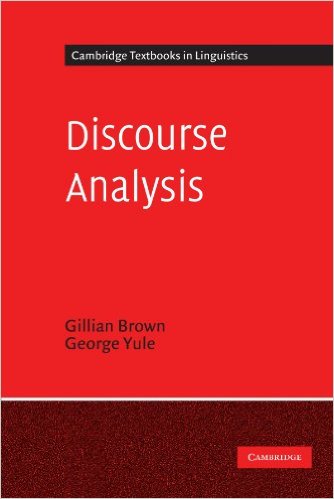
Discourse Analysis (Cambridge Textbooks in Linguistics)
, by Gillian Brown and George Yule (Cambridge University Press, 1983), 302 pages.
Brown and Yule survey the work done thus far on discourse analysis and the various components of what have been included in such work. They deal both with written and with oral texts, sometimes more with oral in order to see language-in-use more naturally. They appreciate the work done by Chomsky and other structural linguists to analyze grammar on the sentence level, but recognize the need for analysis of discourse as a whole.
This work surveys components of discourse analysis such as linguistic forms and functions, context and co-text, topic, staging, information structure, reference, and coherence. The work therefore looks at elements of the author’s composition, the author’s situational context, and the reader’s conception of the discourse. It is helpful for understanding the three components that some authors attribute to meaning: author, text, and audience. Even if one prefers to see meaning only in the author, one must still reckon with what occurs within the text itself and within the mind of the audience if one wants to perform discourse analysis.
The authors work mainly in the field of Hallidayan linguistics, which focuses to a great extent on what contributes to cohesion and coherence in language. Halliday’s theories have been built mainly on the English language, and this work on discourse analysis is geared toward English as well, although they are certainly familiar with other languages. One should beware then that this work presents discourse analysis within the Hallidayan tradition (which Stanley Porter has most prominently used in biblical studies), and that everything in this work will not correspond directly to the Greek language. For example, “staging” in English works quite differently than in Greek, since Greek word order is more fluid than English’s.
The negative aspect of this work is that no method is laid out. They emphasize the developmental nature of discourse analysis (as of 1983), and perhaps this is why they have no developed method. Yet, this volume works as an excellent supplement to Beekman, Callow, and Kopesec’s work. One can use the semantic analysis method found in their work, while supplementing the semantic analysis with the tools provided by Brown and Yule. For other works, see our Discourse Analysis Annotated Bibliography.
Find it here on Amazon.

One comment